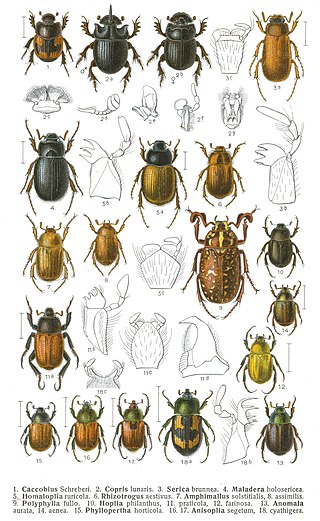
The family Scarabaeidae, as currently defined, consists of over 35,000 species of beetles worldwide; they are often called scarabs or scarab beetles. The classification of this family has undergone significant change in recent years. Several groups formerly treated as subfamilies have been elevated to family rank, and some reduced to lower ranks. The subfamilies listed in this article are in accordance with those in Catalog of Life (2023).

Castellón de la Plana, or simply Castellón is the capital city of the province of Castellón, in the Valencian Community, Spain. It is located in the east of the Iberian Peninsula, on the Costa del Azahar by the Mediterranean Sea. The mountain range known as Desert de les Palmes rises inland north of the town.
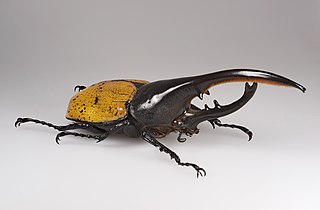
The Hercules beetle is a species of rhinoceros beetle native to the rainforests of southern Mexico, Central America, South America, and the Lesser Antilles. It is the longest extant species of beetle in the world, and is also one of the largest flying insects in the world.

Scrobicularia plana, the peppery furrow shell, is a bivalve mollusc belonging to the family Semelidae.

Planá is a municipality and village in České Budějovice District in the South Bohemian Region of the Czech Republic. It has about 300 inhabitants.

The rain beetles are a group of beetles whose extant species are found only in the far west of North America. They spend most of their lives underground, emerging in response to rain or snow, thus the common name. Formerly classified in the Scarabaeidae, they are currently assigned to their own family Pleocomidae, considered the sister group to all the remaining families of Scarabaeoidea. The family contains a single extant genus, Pleocoma, and two extinct genera, Cretocoma, described in 2002 from Late Cretaceous deposits in Mongolia, and Proteroscarabeus of Late Cretaceous China.

Flower chafers are a group of scarab beetles comprising the subfamily Cetoniinae. Many species are diurnal and visit flowers for pollen and nectar, or to browse on the petals. Some species also feed on fruit. The group is also called fruit and flower chafers, flower beetles and flower scarabs. There are around 4,000 species, many of them still undescribed.
The American Elm cultivar Ulmus americana 'L'Assomption' was selected from seedlings grown from X-irradiated seed at the eponymous experimental station in Quebec before 1965.

Melolonthinae is a subfamily of the scarab beetles. It is a very diverse group; distributed over most of the world, it contains over 11,000 species in over 750 genera. Some authors include the scarab subfamilies Euchirinae and Pachypodinae as tribes in the Melolonthinae.
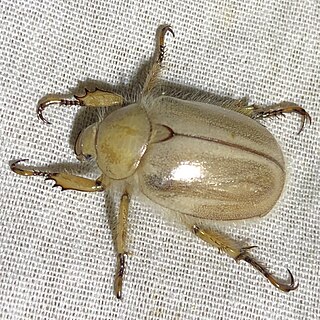
Pseudocotalpa is a small genus of sand dune-inhabiting beetles in the family Scarabaeidae, endemic to deserts of western North America.

Keratocan (KTN) also known as keratan sulfate proteoglycan keratocan, is a protein that in humans is encoded by the KERA gene.

Cornea plana 2(CNA2) is a congenital disorder that causes the cornea to flatten and the angle between the sclera and cornea to shrink. This could result in the early development of arcus lipoides, hazy corneal limbus, and hyperopia. There is evidence that cornea plana 2 is caused by mutations in KERA gene encoding keratocan. Cornea plana 2 is an autosomal recessive disorder.

Synemon is a genus of moths within the family Castniidae. It was described by Edward Doubleday in 1846. The genus contains 24 described and 20 undescribed species. These species are found across mainland Australia and on Kangaroo Island, with the highest diversity in Western Australia. Synemon species can be found in a range of habitats, including woodlands, heathlands and native perennial grasslands. The adults fly during the daytime in warm to hot weather. They have clubbed antennae, and are often mistaken for butterflies.
Plaesiorrhina is a genus of fruit and flower chafers belonging to the family Scarabaeidae, subfamily Cetoniinae, found in Africa.

Chondrorrhina watkinsiana is a beetle belonging to the family Scarabaeidae.

Chondrorrhina mhondana is a species of beetle belonging to the family Scarabaeidae, subfamily Cetoniinae.
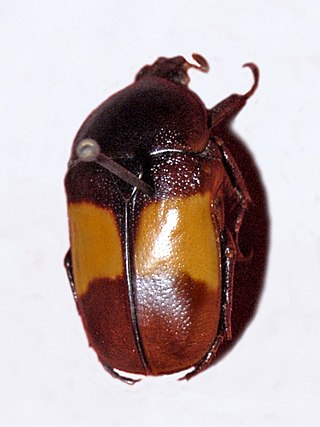
Chondrorrhina abbreviata is a species of fruit and flower chafers belonging to the family Scarabaeidae, subfamily Cetoniinae.
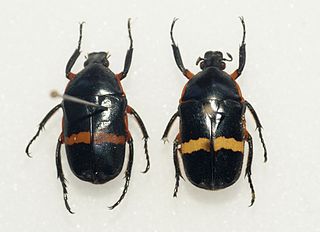
Chondrorrhina is a genus of fruit and flower chafers belonging to the family Scarabaeidae, subfamily Cetoniinae, found in Africa.

Ischiopsopha plana is a species of beetles from the family Scarabaeidae, subfamily Cetoniinae, tribe Schizorhinini.

Chondrorrhina specularis is a species of scarab beetle.


















